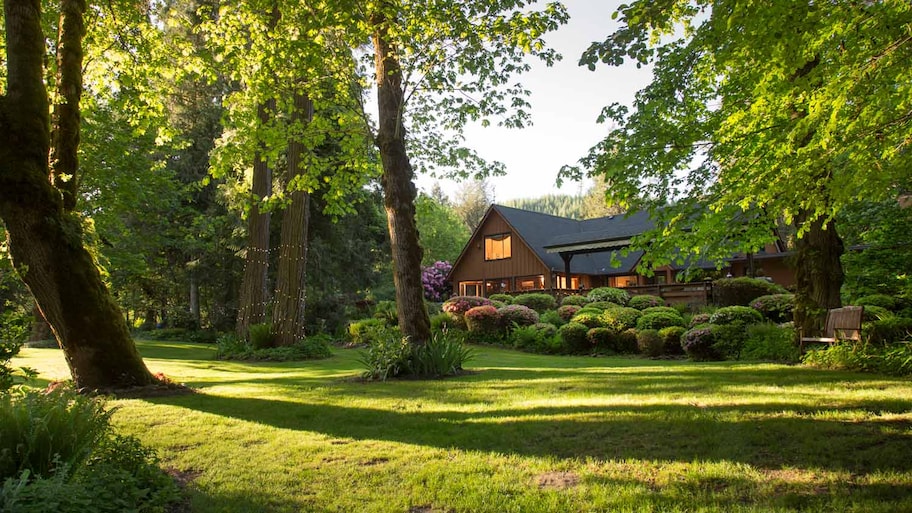How to Tell What Type of Tree You Have in Your Yard
You wood not believe how easy it can be to identify a tree


To identify a tree, you may need to look at the shape and color of its leaves.
Bark is an excellent way to identify a tree in winter when no leaves are present.
Leaf buds, flowers, seeds, and fruit can also tell you more about a tree’s identity.
Perhaps you’ve just moved into your new home and want to understand the flora dotting your backyard, or maybe you’ve been wondering how to identify the tree in your backyard for a long time but didn’t know where to start. Much like leaves on a tree, we’ve got you covered. Read on to learn about the many components of a tree that will help you properly identify it, which in turn will allow you to understand which tree diseases it might be vulnerable to and how to care for it.
Types of Trees By Region
Before using leaf type or bark appearance to identify a tree, find out what species even grow in your area so you don’t waste time looking for something that can’t possibly be there. Although some types grow across the country, like Douglas firs, others can only be found in specific regions.
Common Trees Nationwide
The following tree species are common all around North America, which means that one of them could be on your estate already, no matter where in the country you live.
Douglas fir: can grow anywhere but needs lots of sunlight
American sycamore: can grow anywhere but thrives near creeks and small rivers
American elm: one of the most popular trees in urban areas
Quaking Aspen: grows best at high altitudes
Southern and Western US Trees
The next list of trees can be found all along the West Coast—from north to south—and in some Southern and Midwest states as well.
Lodgepole pine: found from Northern Canada to Baja California
Blue palo verde: found in desert areas in Southern California, Arizona, and Northwestern Mexico
Western hemlock: found across the Pacific Coast.
Yellow poplar: found in Indiana, Kentucky, and Tennessee.
Central and Eastern Trees
The following trees prefer humid conditions and sometimes frightfully cold weather, which is why they can be found all across Eastern and Central states.
White oaks: found in Connecticut, Georgia, Illinois, Iowa, Maryland, and New Jersey
Flowering dogwood: found in Missouri, North Carolina, and Virginia
Red maple: found from Maine to Minnesota and from Texas to Florida
Loblolly pines: grows along the Atlantic coast
Balsam fir: found in Connecticut, Iowa, Michigan, Minnesota, New York, and Pennsylvania
How to Identify Trees by Bark
The bark of a tree can tell you a lot about it, regardless of whether or not there are leaves present. When examining a tree’s bark, you’ll want to take note of its color, texture, and any possible patterns, as these can all help you discover what kind of species you’re working with.
Bark Color
Bark colors vary from tree to tree, but these are some of the most common kinds you will see depending on the species.
Brown: Mulberry and maple
White: Birch, poplar, sycamore, and eucalyptus trees
Silver: Beech, silver birch
White with green undertones: American Aspen
Copper: Paperbark maple or Chinese red birch, Manchurian cherry
Brick red: Black cherry
Silvery gray and brown: Eastern red cedar
Bark Texture
The texture of a tree’s bark will also give you some clues about its identity, including how old it is. It’s also a good idea to know what it typically looks like so you can identify any tree bark issues as they spring up.
Smooth bark: Many young trees have smooth bark, but a few keep their youthful exterior even through adulthood. An adult tree with smooth bark could be an American beech or red maple. If the bark is smooth except for some vertical seams, it could be scarlet oak or shagbark hickory.
Horizontally peeling bark: Many trees have bark that peels away in horizontal strips as they get older. The shagbark hickory and trident maple are two examples.
Ridges and furrows: If the tree looks like it has a tiny, uniform mountain range running across the bark, it could be a white ash (if the ridges and furrows intersect) or a Northern red oak (if the ridges and furrows do not overlap). The white oak’s ridges have breaks in them, running horizontally. These ridges are furrows, gaps in the bark’s top layers, and known as rhytidomes. You can identify an elm tree by looking for rugged bark with deep fissures.
Scaly plates: Sometimes, the rhytidome appears more like plates or like reptilian scales. Several species of pine and spruce trees have a scaly appearance, while the black birch has thick plates on its truck. The dogwood tree’s bark appears in small, block-like plates.
Tree Leaf Identification
If you’re not having much luck determining a tree species you have based on bark alone, take a look at the leaves next. A lot of tree types have similar bark textures, patterns, and colors, but the leaves of each tree are quite unique and examining them first can help you solve your garden mystery more quickly.
By Types of Tree Leaves
Tree leaves, in general, can be divided into two categories: simple and compound. Simple leaves only grow one single component at a time, whereas compound leaves can grow many different components on the same stem. Find out about the three most common types of tree leaves below and whether they fall under the simple or compound umbrella.
Needles: This simple greenery can be found on evergreen trees like pines and firs.
Scales: These compound leaves can be found on certain conifers, like an Arizona cypress.
Broadleaf: These types of leaves can be either compound or simple and are typically found on deciduous trees, though they can also be found on certain evergreens like live oaks.
By Common Leaf Shapes
Leaves come in so many different shapes, but nothing reveals the identity of a tree faster than this characteristic. Find out more about the most common leaf shapes below and which trees they are associated with.
Linear: This type of leaf is long and thin and can be found on trees like the narrowleaf willow.
Lanceolate: These leaves are wide on the bottom and narrow off at the tip and can be found on olive trees and weeping willows.
Oval: As the name suggests, this type of leaf is shaped like an oval and can be found on birch, cherry, and almond trees.
Elliptical: These leaves have narrow points and a wide diameter and are found on American elms.
Truncate: These leaves are flat on the bottom, where they connect to the stem and branch out into unique formations. Poplar and maple leaves fall into this category.
Additional Tree Identifiers

If you’ve run down the list and are still stumped on what kind of tree you have, here are some extra ways to identify it.
Leaf Bud Appearance
The size, scale, and texture of a bud can all help you identify your tree. However, using buds to determine a tree species isn’t the most reliable method because buds only appear at certain times of the year (during spring and summer). Plus, it may be impossible to reach, let alone examine the buds on certain taller and older trees.
Size: Species with large buds include Eastern cottonwood, horse chestnut, black walnut, and hickory trees. On the other hand, you can find small buds on trees like magnolias and crabapple trees.
Bud scale: These are the small flaps that cover a bud, and both the way they’re arranged as well as their color can tell you more about a tree. Valvate bud scales (or those with two flaps) are some of the most common and are linked to species like poplar trees. Some trees, like witch hazel, have naked buds, which means they don’t have any scales at all. Other trees have imbricate buds, which means they have many scales that overlap.
Bud texture: Buds come in textures like smooth, fuzzy, hairy, sticky, and shiny, and each one is associated with a different tree type.
Flowers, Fruits, and Seeds
If you’re lucky enough to have a tree that sprouts fruit, flowers, or seed pods, it can be especially easy to know what type of tree it is.
Flowers: The inflorescence—or petal arrangement around the stalk—is what will tell you what kind of tree is flowering. For example, many fruit trees like pears and apples have blossoms with five petals, whereas non-fruiting trees like lilacs can have far more. Flower color is not always a reliable identification method because shades vary among the same species of tree—like cherry blossoms, which can be either pink or white.
Fruits: If your tree bears fruit, then all you have to do is look at (and even taste, if it’s safe) what it offers to find out what kind of tree it is. Figs grow on fig trees, apricots on apricot trees, and so on.
Seed pods: Many trees also have seed pods, which vary in size, color, texture, and pattern and can make it easier to identify a tree. For example, pines are easy to spot with their recognizable seed pods—also known as pine cones.
Tree Shape
Some trees can be identified by their distinct shapes. Common and easily recognizable tree shapes include:
Pyramidal. Trees with this shape are wider at the bottom and taper to a point at the top. Examples of pyramidal trees include blue spruces and frasier firs.
Weeping. These trees have long, delicate branches that droop toward the ground. Examples include weeping willows and weeping cherry trees.
Oval. These upright trees have a central trunk and branches that form a dense, oval-shaped crown. Examples include white ashes and sugar maples.
What to Do if You Still Can’t Identify Trees in Your Yard
If you’re still staring at your tree absolutely stumped, or you think you might be on the right track, but aren’t sure if you have a maple or an oak tree in your yard, calling in a pro might be wise. While it’s not mandatory to know how to identify trees near your home, it can help to know what they are if they give you any trouble down the road.
A local tree service company can not only let you know which type of tree you’re dealing with, but can also advise you on how to care for it.
C.E. Larusso contributed to this piece.
Frequently Asked Questions
Trees are usually divided into two main categories: Evergreen trees, which keep their foliage year-round, and deciduous trees, which shed their leaves in the fall or winter. You may also see trees categorized as either angiosperms (flowering trees, including fruit trees) or gymnosperms (non-flowering trees, including conifers).
The exact answer to this question depends on which region of the country you’re talking about, but according to various tree counts, some of the most common types of trees in the United States include red maple, Douglas fir, quaking aspen, loblolly pine, and sweetgum.





- When To Cut Down A Tree: 13 Ways To Tell
- Can You Cut Down a Tree on Your Property?
- Why Tree Topping Techniques Are Bad for Your Tree and Your Property
- What Is Eating My Tree Trunk? How to Deal with Tree Borers
- What to Know About Performing Tree Trimming Safety
- Can You Trim Trees in the Summer?
- How to Dispose of Your Christmas Tree Once the Holidays Are Over
- How to Choose Between a Real or an Artificial Christmas Tree
- What To Put On a Tree After Cutting a Branch
- How to Prune Maple Tree Branches: Safe Cutting Tips for Beautiful Foliage










